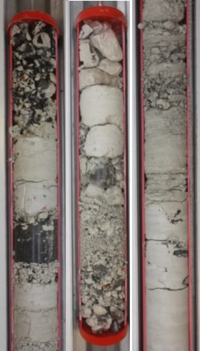Physical processes and governing equations
Contents
Physical processes
Flow in fractured limestone can be very complex, because strongly contrasting flow conditions between fractures and matrix can prevail. The flow in the fractures can be very fast, whereas the limestone matrix has usually low flow velocities, which is characterized by relatively low hydraulic conductivities (or permeabilities). However, for the fate of contaminants in fractured limestone aquifer, both, the fractures and the matrix are important.
The fractures determine the primary transport pathway. The hydraulic conductivity of the fractures is mainly depending on their aperture (width). The connectivity of the fractures has also a decisive influence on the spreading of a substance in the aquifer. For an estimation of the flow velocity in fractures, the cubic law is often used as approximation. With that, the velocity scales with the third power of the fracture aperture. Hence, fractures with a big aperture are far more important as small fractures, since the flow and the velocity are greater in them.
Since it usually has a high porosity and can store substantial amounts of contaminants, once they have diffused into the matrix.
Transport of substances in porous media can be subdivided in advective transport (due to the groundwater flow) and diffusive/dispersive transport. The storage of substances is strongly influenced by sorption of the substance to the porous medium. This is often quantified by sorption coefficients.
Governing equations
Flow
Groundwater flow in porous media is usually described by Darcy's law, giving a relation between hydraulic head gradient and groundwater flow, with the hydraulic conductivity as proportionality factor between the two. The fracture conductivity is usually determined via the fracture aperture using the cubic law.
Flow equation. Cubic law.
Contaminant transport
The advection-dispersion equation describes the transport of a substance in a porous medium. The first term describes storage (here including retardation due to linear sorption), the second and third terms describe advective and dispersive transport of a substance. Degradation can be included as additional source/sink term.
Variables are:
| n | porosity |
| rho_b | bulk density |
| k_d | sorption coefficient |
| c | concentration |
| v | flow velocity |
| D_m | dispersion coefficient |
Properties of limestone
Limestone geologies can be heavily fractured and include almost impermeable chert layers and nodules. Flow predominantly occurs in the fractures due to a much higher hydraulic conductivity as in the limestone matrix. The limestone found at the Akacievej site is a carbonated sand limestone (Copenhagen chalk) and a bryozoan limestone, both with a strongly varying hardness. Due to glacial activity, the uppermost 1-5 meters of the limestone are crushed.
The sorption behavior for chlorinated solvents on limestone was examined in Salzer (2013). For chlorinated solvents like PCE, sorption to limestone can be strong (kd values of 0.5-1 L/kg were observed).
Determined hydraulic properties for the Akacievej field site
The following table gives an overview of values that were determined for the Akacievej site: Include table with typical values for Akacievej
Return to Content
